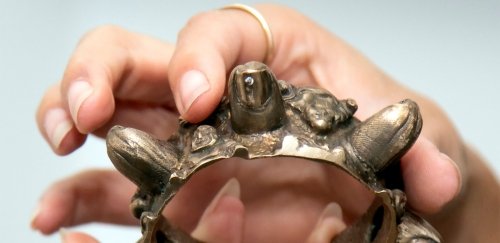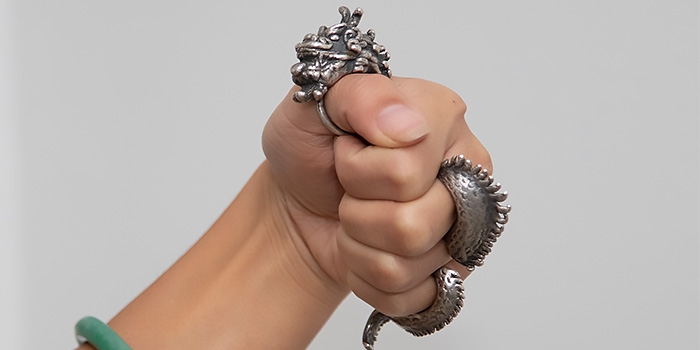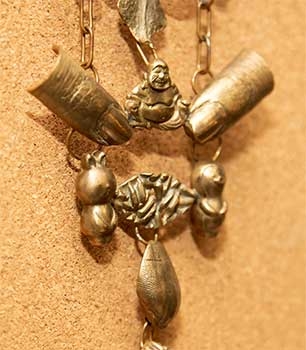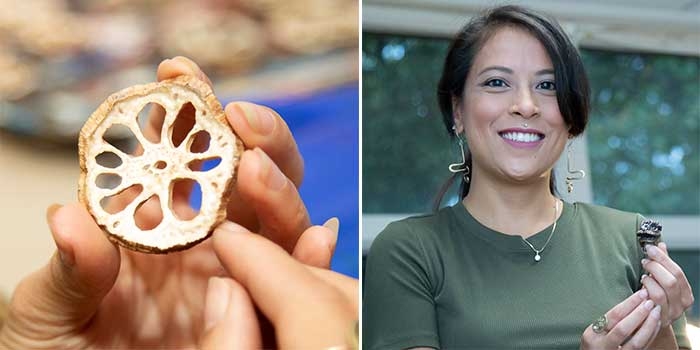Alchemist Searches for Identity through Jewelry Art
- News & Events
- News
- Alchemist Searches for Identity through Jewelry Art

Thoa DiChiara’s jewelry, like identity, is one-of-a-kind. The band of this bracelet is surrounded by Buddhas and molds of the artist’s fingertips.
“I don’t think my jewelry is for everyone,” DiChiara admitted. “If you have a unique personality and you’re looking for something different, I can provide that. But you won’t find my work for sell at Macy’s.”
DiChiara is a Rhode Island College graduate student of art, concentrating in jewelry and metalsmithing, whose jewelry is heavily influenced by her Vietnamese heritage. Her style, she said, is “edgy and weird yet wearable enough that the weirdness is not too overwhelming.”
Among her pieces are tribal necklaces; a self-portrait broach; a dragon’s head ring with a tail that loops around the fingers (the dragon is one of four sacred animals in Vietnam); and a bracelet with molds of the tip of her pointer finger. All of her pieces, she said, reflect her search for identity.


Born in America, DiChiara grew up heavily influenced by American culture. Yet in her household her parents spoke only Vietnamese, and the way they functioned in the world was very culturally connected to Vietnam. DiChiara struggled with identity and with understanding the ways of her parents.
“For instance, coming from a poor country, everything my parents own holds a lot of value to them, so they don’t throw anything away,” she said. “Their home is very crowded with things.”
“My mom reuses everything,” DiChiara said. “She’ll rinse out a paper towel three or four times before she throws it away. She makes things out of nothing. She’ll make something work even if it’s junk. And when she feels she needs something, her first thought is not to go out and buy it. Her first thought is, ‘How can I make this work with what I already have in the house?’ I’m very inspired by her.”
But as a young girl, DiChiara didn’t understand. “I thought our yard looked like a junk yard,” she said. “Our life may have seemed normal to me, but it was very foreign to other people. It was only when I went to Vietnam for the first time that I finally understood why my parents live the way they do. Vietnam is a very poor country, so everyone lives in a very sustainable way. People don’t have a lot, so they need to make more out of the little they have.”
Now DiChiara is preserving that culture, not only for herself but for the next generation of Vietnamese Americans. As part of her graduate thesis, she is designing a series of Vietnamese-inspired head pieces and shoulder pieces to which she will attach Vietnamese food.
Like a modern-day alchemist, she transmutes the food into metal through a process called electroplating or electroforming. First she dehydrates the food. Then she makes an acid bath, using battery acid, copper sulfate, distilled water and electroforming brightener. She places a metal object – a conductor – into the bath, sends electrodes to the object and dips the food into the bath. Tiny particles begin to pull away from the metal object and attach to the food, causing a metal plating to form on top of the food.
“Dehydration preserves the food for a time,” she explained, “but electroplating preserves the food forever. You could say I’m preserving my culture.”
“This project is also a celebratory way of sharing how I experience my culture,” she added. “It was inspired by my mom. She had all this decaying, rotting food in her compost. I looked at it and thought, ‘Oh, my gosh, this looks so beautiful.’ My mom cuts her fruit so that it’s spiralized. It has this really nice movement. I started picking out grapefruit skins, orange peels and seeds.”

“With my mom, it’s all about do it yourself, do it the cheapest way and reuse it,” she said. Indeed, DiChiara’s mother has become adept at the art of transforming matter, and now her daughter is doing the same using chemistry.
“I think immersing myself in my culture will help me with the issue of identity,” she said. “Although I may disagree with some Vietnamese cultural practices, I think it’s important to understand them. If I can understand my roots, then maybe I’ll better understand myself.”
Professor of Metalsmithing Dianne Reilly added that DiChiara, who has two more years before she earns her degree, is focusing her graduate thesis on “bridging two cultures” and that “her work speaks to the history of jewelry in both worlds.” “The result,” Reilly said, “are pieces that are not only successful objects of adornment but catalysts for a personal and cultural narrative, which Thoa expresses in unique and often surprising ways.”
Thoa DiChiara balances graduate school and her studio practice with a full-time position as art teacher at Avon Middle High School in Avon, Massachusetts. She earned her B.A. in both art and education at Bridgewater State University. She would eventually like to create a portfolio of her work and send it to art museums so that they can display and sell her work.
